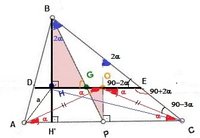petarantes
New member
- Joined
- Oct 21, 2016
- Messages
- 15
In a triangle ABC, H, G, and O are orthocenter, centroid, and circumcenter of the triangle. If the Euler's line is parallel AC and m <(HBC) = 2m <(OCA), calculate GO if AH = a
I tried to draw the triangle and relate the properties but couldn't find a solution. We know that GH = 2GO and BG = 2GP Triangle BHG ~ POG
I tried to draw the triangle and relate the properties but couldn't find a solution. We know that GH = 2GO and BG = 2GP Triangle BHG ~ POG

